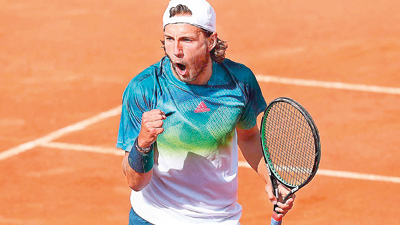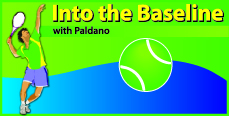The ‘Tight-Rope Walk’

Lucas Pouille
In the ’80s, when Tennis was dominated by Swedes, Bjorn Borg, Mats Wilander and company, there used to be a saying- “There are 3 certainties in Tennis; 1st- Every player will lose one day; 2nd- Every player will physically break down; 3rd- The certainty of the Swedish passing shot”. The Swedes were so good and successful with their ground-strokes, it made the net-game which dominated Tennis in that era, vanish into thin air. Its impact made ‘ground-strokes the base’ for worldwide development. Regardless who dominated, it has been always a ‘tight rope walk’ to survive the Final Rounds of any tournament. In this scenario, either the player has something special to win or, does not, is the reality.
The ‘tight rope walk’ situation is very visible in Grand Slams like the US Open, now on. The rope stretches itself without the safety net, from the 4th Round. The matches in them are ‘survivor battles’ for places in the coveted Final Rounds. It is here the unknown ‘giant killers’ appear to gain a place in the sun or, go, never to be heard again. For the seasoned campaigners, this are ‘booby trapped’ frontiers to cross, never knowing what lurks there. In short, every player will have to do the ‘tight rope walk’ to reap the fame and the very attractive prize money of today.
Mechanics of survival
There is little doubt that, the ‘service’ in Tennis has the biggest tactical value. Using the service advantage to hit a winner or, extending its influence into two more shots could be considered the best insurance to win in this game. Caution! It is not that easy to do consistently, as it sounds. This is the era of super athletes and the 4th Round survivors have a start-up and court coverage speed comparable to Usain Bolt, and they achieve it rally after rally, repeatedly. The Speed-Accuracy equation of hitting the ball hard does not permit a great deal of freedom and insurance to serve and to hit ground-strokes at super speeds all the time. This is the reality. In Tennis, with every error, we give a point to the opponent. So, there are no free rides. With every rally you ‘take or give’.
Tactical Shot Selection
Surviving the service phase, either as a server or receiver, the game goes into the 2nd stage of the rally. Here, ‘tactical shot selection’ is the name of the game. This complex interaction is like surfing the rapids with a tsunami wave on your heels. It is so tight and full of constrains. First, opponents always take away most of the freedom with their shots. Second, a player will have selected shots that could be played ‘error free’ in a fraction of a second. Third, the shot selected will have to stop opponent’s attack and open up the court to the player. Fourth, the player should be able to position self to cover own court, which is very large in Tennis as an individual sport.
 Fifth, to control pace and not be trapped by own ‘top gear’ overdrives. Increasing speed to make it effective against the opponent also reduces the time available to the player for the next shot, if it is returned. This is a ‘double headed’ trap and many novices fall prey to this. This ‘rally-battle’ based on shot selection is a very dangerous ‘tight rope walk’ without a safety net, as sometimes, it lasts for over 4 hours. Not knowing this, all beginners and age-group players indulge in speed and usually pay a price.
Fifth, to control pace and not be trapped by own ‘top gear’ overdrives. Increasing speed to make it effective against the opponent also reduces the time available to the player for the next shot, if it is returned. This is a ‘double headed’ trap and many novices fall prey to this. This ‘rally-battle’ based on shot selection is a very dangerous ‘tight rope walk’ without a safety net, as sometimes, it lasts for over 4 hours. Not knowing this, all beginners and age-group players indulge in speed and usually pay a price.
US Open – Good performances
There has been a good share of exciting Tennis at the current US Open. Three Frenchmen reached the Quarters and are in the same half of the Men’s draw. One of them, 22-year-old Lucas Pouille, ranked 25, sent reputed Rafael Nadal home with a most impressive win. There was no visible weakness in Nadal; just that Pouille was amazingly good with his game. Caroline Wozniacki the Danish Queen is back in the limelight and, this time, with very good Tennis. USA’s Serena Williams and Germany’s Angelique Kerber playing precision Tennis are thrilling Tennis fans. The Top 5 player Halep is improving her game rhythm and is a threat to all. Physical breakdown has caused too many early retirements in this US Open. Djokovic had 3 retirement wins in his run into the semi-finals so far. He is nursing his wrist and shoulders.
Nations and success
Although the US Open is an individual event, the prominence a player gives to his nationality is immense. Right now, undoubtedly, the continent that is dominating Tennis is Europe. From the American continent USA, Argentina and Canada have a good representation. From Asia it is China and Japan, and India is doing well in Doubles. Australia has more players now but, only in the early Rounds. The Olympics could not produce the excitement of the US Open in Tennis.
The restriction in participation and Rio as the venue, made Olympic Tennis more a closed event. The 3 certainties of the ‘’80s’ still seem valid, just that the number of countries in prominence has increased. This means the ‘tight rope’ is spanning a longer gap and the safety net has shrunk. Tennis was never very kind to players, because its excitement is based on ‘winning by killing’. George Paldano, Former int. player; Accredited Coach of Germany; National, Davis-Cup, Federation Cup coach–. georgepaldano@yahoao.com


